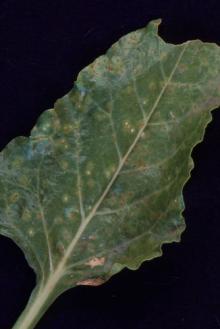Cause The fungus, Uromyces betae, which does not require an alternate host to complete its lifecycle. It overwinters on volunteer beets and in infected plant debris and may also be seedborne. Disease development is favored by cool (59°F to 70°F), moist weather. The disease commonly occurs late in the season but usually is not destructive enough to reduce yields.
Symptoms Small reddish-brown spots (uredinia) are on leaf surfaces, petioles, and seed stalks. A dark brown spore stage (telia) sometimes is found on leaves toward the end of the growing season. Sometimes the disease destroys the tops, making it difficult to pull the beets.
Cultural control
- After harvest, plow under plant refuse to reduce inoculum.
Chemical control
- Fontelis (Group 7) at 16 to 30 fl oz/A on 7- to 14-day intervals. Do not make more than two (2) sequential applications before alternating to a labeled fungicide with a different mode of action (non-Group 7). Preharvest interval is 0 days. 12-hr reentry.
- JMS Stylet-Oil at 3 to 6 quarts/100 gal water. Do not spray if temperature is below 50°F or above 90°F or when plants are wet or under heat or moisture stress. 4-hr reentry. O
- Mancozeb formulations (Group M3) are labeled.
- Dithane F45 Rainshield at 1.5 quart/A on 7- to 10-day intervals can be used on seed crops only. Washington and Oregon only (SLN WA-220008, SLN OR-240011). 24-hr reentry.
- Roper DF Rainshield at 2 lb/A on 7- to 10-day intervals can be used on seed crops in Washington (SLN WA-1300003). 24-hr reentry.
- Quadris Flowable (Group 11) at 6 to 15.5 fl oz/A on 7- to 14-day intervals. Do not apply more than one (1) foliar application of any Group 11 fungicide before alternating to a labeled fungicide with a different mode of action. May be applied the day of harvest. 4-hr reentry.
- Wettable sulfur.

